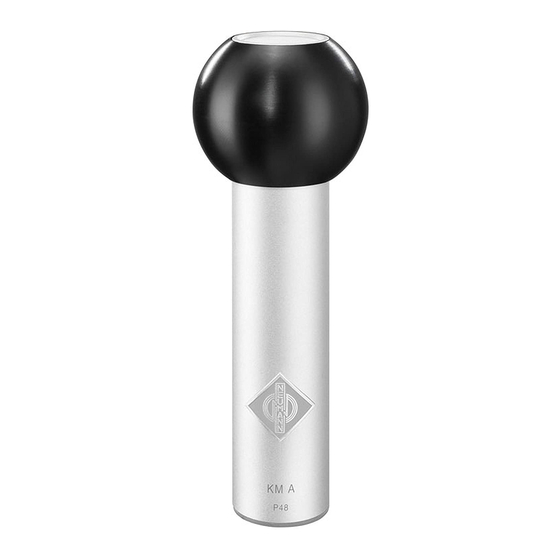
Werbung
Quicklinks
K
S
SBK 130 A
Funktion
Die Schallbeugungskugel SBK 130 A kann auf
die Druckempfänger KM 130, KM 131 (A/D) oder
KM 183 (A/D) gesteckt werden, so dass jeweils die
Membran einen Teil der Kugeloberfl äche bildet.
Damit wird bei diesen Mikrofonen der Frequenzbe-
reich zwischen 2 kHz und 10 kHz für Schalleinfall
aus dem vorderen Halbraum um maximal 2,5 dB an-
gehoben, während Schallanteile aus dem hinteren
Halbraum ab etwa 5 kHz um maximal 2,5 dB abge-
senkt werden. Die Schalleinfalls-Richtungen 90°
(Seite) und 180° (hinten) werden nicht beeinfl usst.
Durch die Schallbeugungskugel erhalten die Druck-
mikrofone einen früheren und sanft eren Druckan-
stieg im mittleren und oberen Frequenzbereich.
Die Bündelung im oberen Frequenzbereich nimmt
ähnlich einem Druckgradientenempfänger zu, wo-
bei das Mikrofon als Druckempfänger aber ein bis
zu tiefsten Frequenzen lineares Übertragungsmaß
liefert. Die stärkere Bündelung erlaubt einen grö-
ßeren Aufnahmeabstand und macht KM 130 sowie
KM 183 (A/D) besonders geeignet als Stereohaupt-
mikrofone in A-B-Anordnung.
Handhabung
Die Schallbeugungskugel SBK 130 A
wird auf das Mikrofon gesteckt,
bis die Kugel bündig mit der Mik-
rofon-Vorderkante abschließt. Die
Montagerichtung ergibt sich aus der
Fase an der Bohrung.
Sicherheitshinweis
Vor der Verwendung der SBK über-
prüfen Sie diese auf festen Sitz auf
dem Mikrofon.
B
SBK 130 A
S
S
Function
The sound diff raction sphere attaches to the front
of the KM 130, KM 131 (A/D) or KM 183 (A/D). The
diaphragm of the microphone capsule becomes an
integral part of the front surface in the sphere. This
modifi cation of the microphone shape changes its
frequency response characteristic. Sound compo-
nents reaching the microphone from the front half-
space are emphasized as much as 2.5 dB between
2 kHz and 10 kHz. In contrast, sound components
reaching the microphone from the rear half- space
are attenuated by about 2.5 dB by frequencies
above 5 kHz. Sound coming from the side (90°) or
from the rear (180°) is not aff ected.
The result is a microphone with a smooth and
gradual rise in pressure build-up of the middle and
upper frequencies. In this higher frequency range
the directivity increases, similar to a pressure
gradient microphone. In the remaining frequency
range, down to the lowest frequencies, the micro-
phone has a very linear response, as is typical for
a pressure transducer. The increased directivity
permits a greater pickup distance from the sound
source without loss of high frequencies. KM 130
and KM 183 (A/D) are especially suitable for use as
stereo main microphones in A-B confi guration.
Kapsel/Capsule
D
Operation
Slip the SBK 130 A Sound Diff rac-
tion Sphere on to the microphone
until the capsule is fl ush with its
front edge. The direction of assem-
bly is defi ned by the bevel at the
bore.
Safety Instruction
Before use check the SBK for a close
fi t on the microphone.
Werbung

Inhaltszusammenfassung für Neumann.Berlin SBK 130 A
- Seite 1 A-B confi guration. Handhabung Operation Die Schallbeugungskugel SBK 130 A Slip the SBK 130 A Sound Diff rac- wird auf das Mikrofon gesteckt, tion Sphere on to the microphone bis die Kugel bündig mit der Mik- until the capsule is fl ush with its rofon-Vorderkante abschließt.
- Seite 2 KM 183 (A/D)] mit 22 mm Durchmesser. (A/D), KM 183 (A/D)] with 22 mm diameter. Frequenzgänge und Polardiagramme mit SBK 130 A / Frequency Range and Polar Patterns with SBK 130 A KM 130/ KM 183 (A/D) KM 131 (A/D) gemessen im freien Schallfeld nach IEC 60268-4, Toleranz ±2 dB...